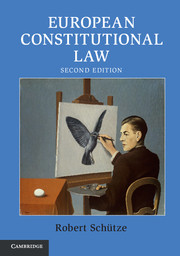Book contents
- Frontmatter
- Dedication
- Summary Contents
- Contents
- List of Illustrations
- List of Tables
- List of Cases
- List of Secondary Law
- Table of Equivalents
- List of Abbreviations
- Acknowledgements
- Introduction: European Constitutional Law
- Part I Constitutional Foundations
- Part II Governmental Powers
- 7 Legislative Powers: Competences and Procedures
- 8 External Powers: Competences and Procedures
- 9 Executive Powers: Competences and Procedures
- 10 Judicial Powers I: (Centralised) European Procedures
- 11 Judicial Powers II: (Decentralised) National Procedures
- 12 Judicial Powers III: EU Fundamental Rights
- Appendices
- Index
- References
7 - Legislative Powers: Competences and Procedures
from Part II - Governmental Powers
- Frontmatter
- Dedication
- Summary Contents
- Contents
- List of Illustrations
- List of Tables
- List of Cases
- List of Secondary Law
- Table of Equivalents
- List of Abbreviations
- Acknowledgements
- Introduction: European Constitutional Law
- Part I Constitutional Foundations
- Part II Governmental Powers
- 7 Legislative Powers: Competences and Procedures
- 8 External Powers: Competences and Procedures
- 9 Executive Powers: Competences and Procedures
- 10 Judicial Powers I: (Centralised) European Procedures
- 11 Judicial Powers II: (Decentralised) National Procedures
- 12 Judicial Powers III: EU Fundamental Rights
- Appendices
- Index
- References
Summary
Introduction
Each society needs common rules and mechanisms for their production. The concept of legislation is central to all modern societies. Legislation refers to the making of laws (legis).
But what is ‘legislation’? Two competing conceptions of legislation have emerged in the modern era. The formal or procedural conception of legislation is tied to our modern understanding of who should be in charge of the legislative function. Legislation is formally defined as every legal act adopted according to the (parliamentary) legislative procedure. This procedural conception of legislation has traditionally shaped British constitutional thought. By contrast, a second conception defines what legislation should be, that is: legal rules with general application. This material or functional conception of legislation has shaped continental constitutional thought. A material definition of legislation underpins phrases like ‘external legislation’ through international agreements, and ‘delegated legislation’ adopted by the executive.
Which of these traditions has informed European constitutionalism? The Union has traditionally followed a material definition. However, with the Lisbon Treaty, a formal definition of legislative power has been adopted. The Treaty on the Functioning of the European Union now constitutionally defines: ‘Legal acts adopted by legislative procedure shall constitute legislative acts.’
But what are the ‘legislative’ powers of the European Union? And what types of power can it enjoy? This chapter answers these questions in four sections. Section 1 analyses the scope of the Union's legislative competences. This scope is limited, as the Union is not a sovereign State. Section 2 analyses the different categories of Union competences. Depending on what competence category is involved, the Union will enjoy distinct degrees of legislative power. Section 3 analyses the identity of the Union legislator. Various legislative procedures thereby determine how the Union must exercise its ‘legislative’ competences. Section 4 finally scrutinises the principle of subsidiarity as a constitutional principle that controls the exercise of the Union's shared legislative powers.
The Scope of Union Competences
When the British Parliament legislates, it need not ‘justify’ its acts. It is considered to enjoy a competence to do all things. This ‘omnipotence’ is inherent in the idea of a sovereign parliament in a sovereign state. The European Union is neither ‘sovereign’ nor a ‘state’. Its powers are not inherent powers. They must be conferred by its foundational charter: the European Treaties.
- Type
- Chapter
- Information
- European Constitutional Law , pp. 223 - 262Publisher: Cambridge University PressPrint publication year: 2015



